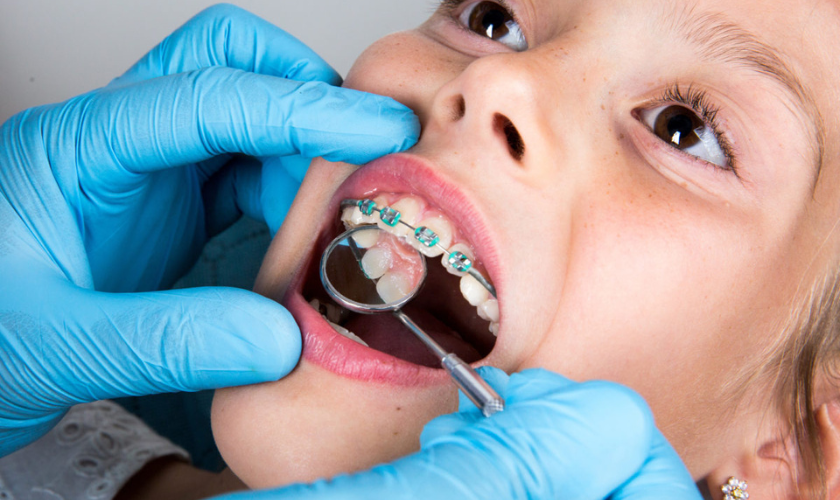Orthodontic intervention refers to the early treatment of dental and jaw misalignment issues in children. It aims to correct these problems before they become more severe and harder to rectify. While braces and other orthodontic treatments are commonly associated with teenagers, there are significant benefits to starting orthodontic intervention at a younger age.
Children’s bones are still growing and developing, making it easier to shape and guide them into the correct alignment. Moreover, intervening at a young age can prevent potential issues like overcrowded teeth, misaligned jaws, and improper facial growth. By addressing these concerns early on, children can enjoy a more aesthetically pleasing smile, improved oral health, and increased self-confidence as they grow. Early orthodontic intervention can have a positive impact on a child’s overall well-being and can potentially reduce the need for extensive orthodontic treatment later in life.
Now that we’ve explored the concept of early orthodontic intervention and its potential benefits for children, let’s delve into the key takeaways. In the upcoming sections, we will discuss five significant advantages of starting orthodontic treatment at an early age. Each of these benefits plays a crucial role in promoting proper dental development, minimizing future complications, and enhancing children’s quality of life. So, without further ado, let’s discover the top five advantages of early orthodontic intervention for children.
key Takeaways
1. Early orthodontic intervention for children can help prevent more serious dental issues later in life. By addressing problems such as crowding or misalignment at a young age, orthodontists can guide the growth and development of the teeth and jaw to create a proper alignment, reducing the need for more extensive treatments like braces or surgery in the future. If you’re considering early orthodontic intervention, Drs Orthodontics offers a complimentary consult to discuss the best options for your child’s dental health.
2. Improved aesthetics and self-esteem are significant benefits of early orthodontic intervention. By correcting crooked or protruding teeth, children can have a healthier and more attractive smile, leading to increased confidence and improved social interactions during their formative years.
3. Early intervention can assist in correcting harmful oral habits that can impact dental health and speech development. Thumb sucking, tongue thrusting, or mouth breathing can lead to incorrect tooth positioning, jaw growth problems, and speech difficulties. Evaluating and addressing these habits in their early stages can minimize their risks and promote healthy oral development.
4. Early orthodontic treatment can help solve bite problems, such as overbite, underbite, or crossbite. By correcting the alignment of the teeth and jaws, orthodontists can improve chewing and speech function while reducing the risk of tooth decay, gum disease, and jaw joint issues caused by malocclusion.
5. The benefits of early orthodontic intervention extend beyond dental health. Properly aligned teeth can improve overall physical health by reducing the risk of jaw pain, headaches, and neck or shoulder discomfort caused by strain from an improper bite. Additionally, a healthy smile in childhood can contribute to greater overall well-being and success in adulthood.
What are the Top 5 Benefits of Early Orthodontic Intervention for Children?
1. Improved Oral Health
Early orthodontic intervention can help improve the oral health of children in several ways. First, it can correct tooth misalignment and bite issues, which can lead to difficulties in speaking, chewing, and swallowing. By addressing these problems early on, children can develop better oral function and overall oral health. Additionally, early orthodontic intervention can prevent the development of more severe dental issues in the future, such as gum disease and tooth decay.
2. Enhanced Facial Growth and Development
Early orthodontic intervention focuses on guiding the growth and development of the child’s facial structures, including the jaw and teeth. By correcting misalignments and bite problems at an early age, orthodontists can encourage proper facial growth and prevent potential issues such as jaw asymmetry or uneven growth. This intervention can lead to a more balanced and harmonious facial appearance, boosting the child’s self-esteem and confidence.
3. Preventive Measures for Future Orthodontic Treatment
Early orthodontic intervention can act as a preventive measure to reduce the need for extensive orthodontic treatment in the future. By identifying and addressing potential orthodontic issues early on, such as overcrowding or jaw discrepancies, orthodontists can minimize the complexity and duration of treatment required later in life. This can save both time and money, as well as reduce potential discomfort for the child.
4. Improved Speech and Pronunciation
Orthodontic issues such as malocclusions or misaligned teeth can affect a child’s speech and pronunciation. Early intervention can target and correct these issues, allowing children to develop clear and correct speech patterns. By aligning the teeth and jaw properly, speech difficulties and impediments can be minimized or even eliminated, improving the child’s communication skills and overall confidence.
5. Psychological and Emotional Benefits
Addressing orthodontic issues early on can have significant psychological and emotional benefits for children. Correcting misaligned teeth and bite problems can enhance their self-esteem and self-image. It can prevent potential teasing or bullying due to dental irregularities, promoting positive social interactions and mental well-being. By fostering a healthy and confident smile from an early age, children are more likely to have a positive outlook on dental care and embrace good oral hygiene habits.
What can parents do to support early orthodontic intervention?
- Schedule regular dental check-ups to monitor your child’s oral development.
- Learn about the signs and symptoms of orthodontic problems, such as crowding or teeth misalignment.
- Encourage your child to maintain good oral hygiene habits, including brushing and flossing regularly.
- Discuss any concerns about your child’s oral health or development with a qualified orthodontist.
- Follow the orthodontist’s recommendations and advice for early intervention, if necessary.
FAQ
1. What is early orthodontic intervention?
Early orthodontic intervention refers to the assessment and treatment of dental and jaw issues in children as young as seven years old. It aims to address potential problems before they worsen and help guide proper dental development.
2. What are the benefits of early orthodontic intervention?
Early orthodontic intervention can prevent or minimize the need for extensive orthodontic treatment later in life. It helps correct bite issues, overcrowding, and misaligned teeth, leading to improved oral health, better aesthetics, and increased self-confidence.
3. How does early orthodontic intervention impact dental health?
Early intervention can prevent the development of more severe oral health issues. By addressing problems early on, the risk of tooth decay, gum disease, and jaw disorders can be reduced, promoting overall dental health and well-being.
4. Is early orthodontic intervention painful for children?
No, early orthodontic intervention is not generally painful for children. The treatment options available for young patients are designed to be comfortable and less invasive compared to traditional braces or other treatments used in later years.
5. Can early orthodontic intervention improve facial aesthetics?
Yes, early orthodontic intervention can improve facial aesthetics. By correcting dental and jaw issues, it can enhance the symmetry and balance of the face, improving the overall appearance and harmonizing facial features.
6. How long does early orthodontic intervention usually last?
The duration of early orthodontic intervention varies depending on the specific needs of each child. Some cases may only require a few months, while others may require a couple of years. Your orthodontist will determine the best treatment plan for your child.
7. What types of early orthodontic intervention are available?
There are several types of early orthodontic intervention, including removable appliances, orthodontic braces, or space maintainers. Your orthodontist will recommend the most suitable option based on your child’s specific needs.
8. Is early orthodontic intervention covered by insurance?
Many dental insurance plans cover a portion of the cost of early orthodontic intervention. However, coverage varies, so it’s important to check with your insurance provider to understand the extent of the coverage and any potential limitations.
9. When is the best time to seek early orthodontic intervention?
The American Association of Orthodontists recommends children to have their first orthodontic evaluation by the age of seven. However, every child is different, and early intervention can occur at any age if dental or jaw issues are detected.
10. What happens after early orthodontic intervention?
After early orthodontic intervention, your child may require additional orthodontic treatment as they grow older. This can include wearing braces or utilizing other orthodontic appliances to fine-tune the teeth positioning and ensure long-lasting results.
Final Thoughts
Early orthodontic intervention for children offers numerous benefits that extend beyond just aesthetic improvements. By addressing potential issues early on, parents can help their children achieve better oral health, improved facial aesthetics, and increased self-esteem. It is crucial to consult with an experienced orthodontist to assess your child’s needs and determine the most appropriate treatment plan.
Investing in early orthodontic intervention can provide long-term benefits, such as reducing the need for extensive orthodontic treatment in the future. By taking preventive measures, parents can help their children avoid more complicated dental problems later in life and ensure they have a healthy and confident smile throughout their adulthood.






